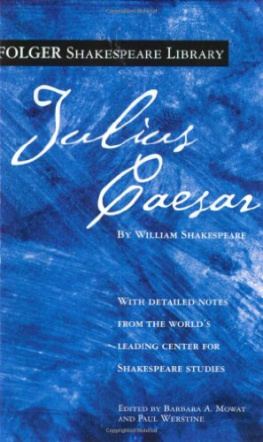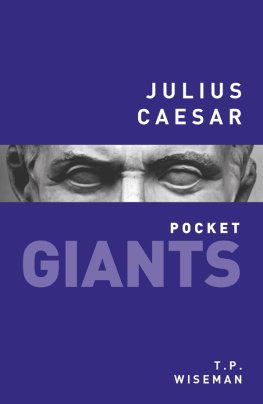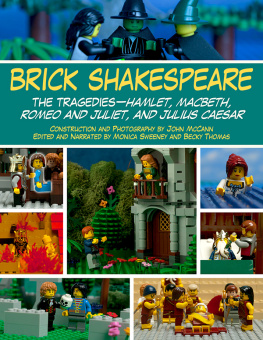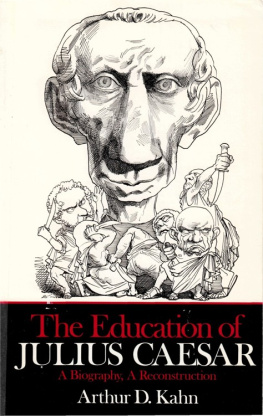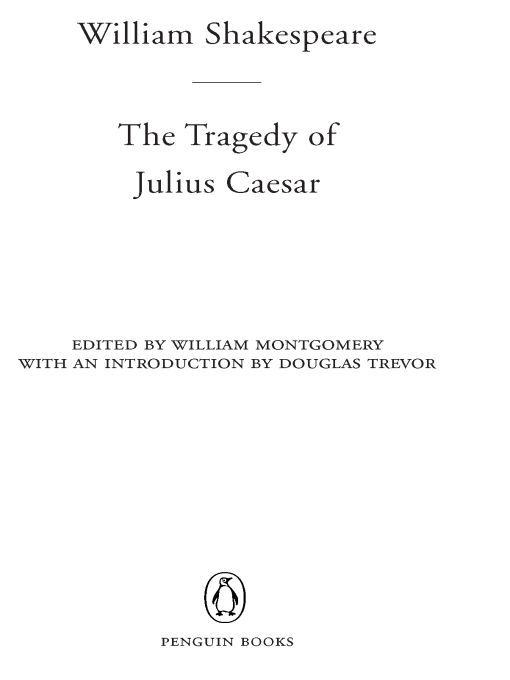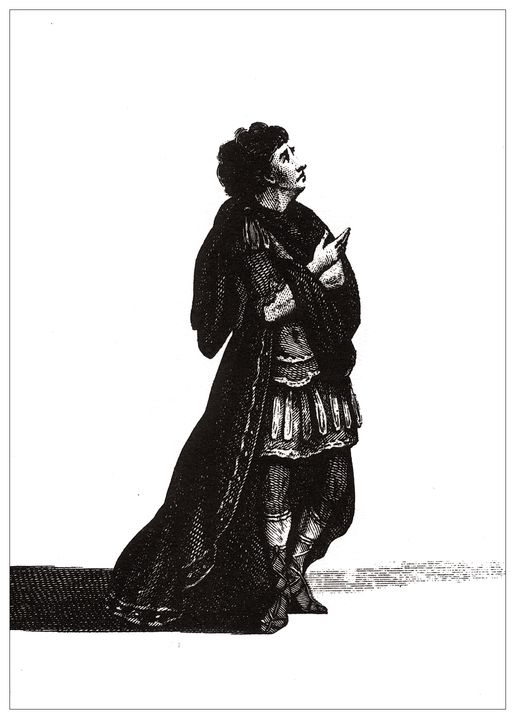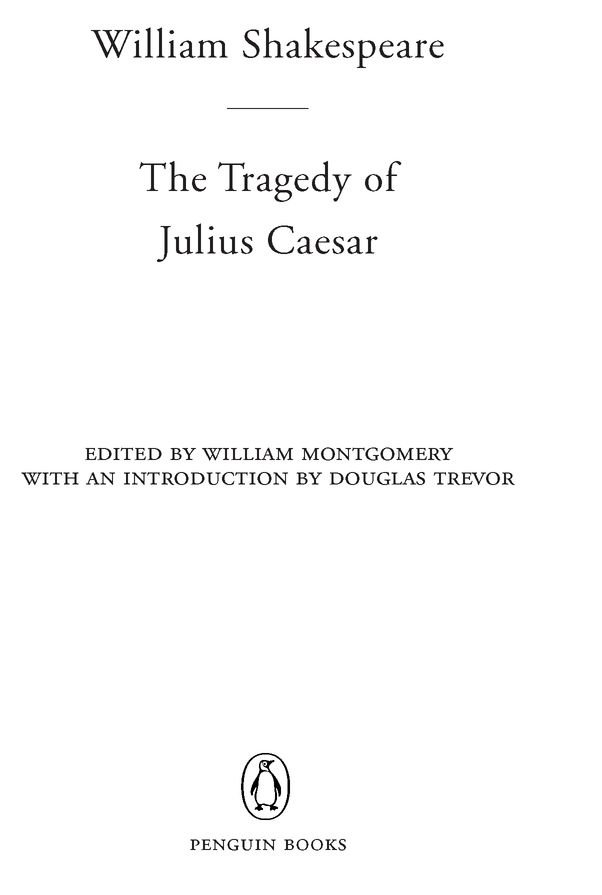Table of Contents
THE PELICAN SHAKESPEARE GENERAL EDITORS STEPHEN ORGEL A. R. BRAUNMULLER
The Tragedy of Julius Caesar
The Irish actor Thomas Sheridan (father of the playwright Richard Brinsley Sheridan) in his most famous role as Brutus, first performed at Covent Garden in 1744. His manner was cool, formal, and intellectual, admirably suited to Brutus, though he was criticized for lacking Garricks naturalness. From Bells Shakespeare (1773-76).
Publishers Note
IT IS ALMOST half a century since the first volumes of the Pelican Shakespeare appeared under the general editorship of Alfred Harbage. The fact that a new edition, rather than simply a revision, has been undertaken reflects the profound changes textual and critical studies of Shakespeare have undergone in the past twenty years. For the new Pelican series, the texts of the plays and poems have been thoroughly revised in accordance with recent scholarship, and in some cases have been entirely reedited. New introductions and notes have been provided in all the volumes. But the new Shakespeare is also designed as a successor to the original series; the previous editions have been taken into account, and the advice of the previous editors has been solicited where it was feasible to do so.
Certain textual features of the new Pelican Shakespeare should be particularly noted. All lines are numbered that contain a word, phrase, or allusion explained in the glossarial notes. In addition, for convenience, every tenth line is also numbered, in italics when no annotation is indicated. The intrusive and often inaccurate place headings inserted by early editors are omitted (as is becoming standard practice), but for the convenience of those who miss them, an indication of locale now appears as the first item in the annotation of each scene.
In the interest of both elegance and utility, each speech prefix is set in a separate line when the speakers lines are in verse, except when those words form the second half of a verse line. Thus the verse form of the speech is kept visually intact. What is printed as verse and what is printed as prose has, in general, the authority of the original texts. Departures from the original texts in this regard have only the authority of editorial tradition and the judgment of the Pelican editors; and, in a few instances, are admittedly arbitrary.
The Theatrical World
ECONOMIC REALITIES determined the theatrical world in which Shakespeares plays were written, performed, and received. For centuries in England, the primary theatrical tradition was nonprofessional. Craft guilds (or mysteries) provided religious drama - mystery plays - as part of the celebration of religious and civic festivals, and schools and universities staged classical and neoclassical drama in both Latin and English as part of their curricula. In these forms, drama was established and socially acceptable. Professional theater, in contrast, existed on the margins of society. The acting companies were itinerant; playhouses could be any available space - the great halls of the aristocracy, town squares, civic halls, inn yards, fair booths, or open fields - and income was sporadic, dependent on the passing of the hat or on the bounty of local patrons. The actors, moreover, were considered little better than vagabonds, constantly in danger of arrest or expulsion.
In the late 1560s and 1570s, however, English professional theater began to gain respectability. Wealthy aristocrats fond of drama - the Lord Admiral, for example, or the Lord Chamberlain - took acting companies under their protection so that the players technically became members of their households and were no longer subject to arrest as homeless or masterless men. Permanent theaters were first built at this time as well, allowing the companies to control and charge for entry to their performances.
Shakespeares livelihood, and the stunning artistic explosion in which he participated, depended on pragmatic and architectural effort. Professional theater requires ways to restrict access to its offerings; if it does not, and admission fees cannot be charged, the actors do not get paid, the costumes go to a pawnbroker, and there is no such thing as a professional, ongoing theatrical tradition. The answer to that economic need arrived in the late 1560s and 1570s with the creation of the so-called public or amphitheater playhouse. Recent discoveries indicate that the precursor of the Globe playhouse in London (where Shakespeares mature plays were presented) and the Rose theater (which presented Christopher Marlowes plays and some of Shakespeares earliest ones) was the Red Lion theater of 1567. Archaeological studies of the foundations of the Rose and Globe theaters have revealed that the open-air theater of the 1590s and later was probably a polygonal building with fourteen to twenty or twenty-four sides, multistoried, from 75 to 100 feet in diameter, with a raised, partly covered thrust stage that projected into a group of standing patrons, or groundlings, and a covered gallery, seating up to 2,500 or more (very crowded) spectators.
These theaters might have been about half full on any given day, though the audiences were larger on holidays or when a play was advertised, as old and new were, through printed playbills posted around London. The metropolitan areas late-Tudor, early-Stuart population (circa 1590-1620) has been estimated at about 150,000 to 250,000. It has been supposed that in the mid-1590s there were about 15,000 spectators per week at the public theaters; thus, as many as 10 percent of the local population went to the theater regularly. Consequently, the theaters repertories - the plays available for this experienced and frequent audience - had to change often: in the month between September 15 and October 15, 1595, for instance, the Lord Admirals Men performed twenty-eight times in eighteen different plays.
Since natural light illuminated the amphitheaters stages, performances began between noon and two oclock and ran without a break for two or three hours. They often concluded with a jig, a fencing display, or some other nondramatic exhibition. Weather conditions determined the season for the amphitheaters: plays were performed every day (including Sundays, sometimes, to clerical dismay) except during Lent - the forty days before Easter - or periods of plague, or sometimes during the summer months when law courts were not in session and the most affluent members of the audience were not in London.
To a modern theatergoer, an amphitheater stage like that of the Rose or Globe would appear an unfamiliar mixture of plainness and elaborate decoration. Much of the structure was carved or painted, sometimes to imitate marble; elsewhere, as under the canopy projecting over the stage, to represent the stars and the zodiac. Appropriate painted canvas pictures (of Jerusalem, for example, if the play was set in that city) were apparently hung on the wall behind the acting area, and tragedies were accompanied by black hangings, presumably something like crepe festoons or bunting. Although these theaters did not employ what we would call scenery, early modern spectators saw numerous large props, such as the bar at which a prisoner stood during a trial, the mossy bank where lovers reclined, an arbor for amorous conversation, a chariot, gallows, tables, trees, beds, thrones, writing desks, and so forth. Audiences might learn a scenes location from a sign (reading Athens, for example) carried across the stage (as in Bertolt Brechts twentieth-century productions). Equally captivating (and equally irritating to the theaters enemies) were the rich costumes and personal props the actors used: the most valuable items in the surviving theatrical inventories are the swords, gowns, robes, crowns, and other items worn or carried by the performers.



